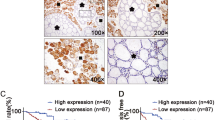Abstract
Objectives
To investigate the biological functions of microRNA-144-3p with respect to proliferation and apoptosis of human salivary adenoid carcinoma cell lines via mTOR.
Results
After transfection of microRNA-144-3p agomir, cell viability assays confirmed that the salivary adenoid carcinoma cell (SACC) proliferation was inhibited and apoptosis was induced. Dual luciferase reporter assay validated that the mammalian target of rapamycin (mTOR) was a direct target of miR-144-3p. Western blot, immunofluorescent analysis and a xenograft mouse model of adenoid cystic carcinoma indicated that miR-144-3p was a tumor suppressor and repressed mTOR expression and signaling in SACCs.
Conclusions
MicroRNA-144-3p inhibits proliferation and induces apoptosis of human salivary adenoid carcinoma cells by downregulating mTOR expression in vitro and in vivo.




Similar content being viewed by others
References
Bu LL, Deng WW, Huang CF, Liu B, Zhang WF, Sun ZJ (2015) Inhibition of STAT3 reduces proliferation and invasion in salivary gland adenoid cystic carcinoma. Am J Cancer Res 5:1751–1761
Cao T, Li H, Hu Y, Ma D, Cai X (2014) miR-144 suppresses the proliferation and metastasis of hepatocellular carcinoma by targeting E2F3. Tumour Biol 35:10759–10764
Chen X et al (2011) Epigenetics, microRNAs, and carcinogenesis: functional role of microRNA-137 in uveal melanoma. Invest Ophthalmol Sci 52:1193–1199
Gobin B et al (2014) NVP-BEZ235, a dual PI3 K/mTOR inhibitor, inhibits osteosarcoma cell proliferation and tumor development in vivo with an improved survival rate. Cancer Lett 344:291–298
Grabinski N, Ewald F, Hofmann BT, Staufer K, Schumacher U, Nashan B, Jucker M (2012) Combined targeting of AKT and mTOR synergistically inhibits proliferation of hepatocellular carcinoma cells. Mol Cancer 11:85
Guo Y et al (2013) miR-144 downregulation increases bladder cancer cell proliferation by targeting EZH2 and regulating Wnt signaling. FEBS J 280:4531–4538
He SQ, Gao M, Fu YF, Zhang YN (2015) Glycyrrhizic acid inhibits leukemia cell growth and migration via blocking AKT/mTOR/STAT3 signaling. Int J Clin Exp Pathol 8:5175–5181
Kalimutho M et al (2011) Differential expression of miR-144* as a novel fecal-based diagnostic marker for colorectal cancer. J Gastroenterol 46:1391–1402
Li M, Sun H, Song L, Gao X, Chang W, Qin X (2012) Immunohistochemical expression of mTOR negatively correlates with PTEN expression in gastric carcinoma. Oncol Lett 4:1213–1218
Li N, Sui J, Liu H, Zhong M, Zhang M, Wang Y, Hao F (2015a) Expression of phosphorylated Akt/mTOR and clinical significance in human ameloblastoma. Int J Clin Exp Med 8:5236–5244
Li T, Luo W, Liu K, Lv X, Xi T (2015b) miR-31 promotes proliferation of colon cancer cells by targeting E2F2. Biotechnol Lett 37:523–532
Mitani Y, Roberts DB, Fatani H, Weber RS, Kies MS, Lippman SM, El-Naggar AK (2013) MicroRNA profiling of salivary adenoid cystic carcinoma: association of miR-17-92 upregulation with poor outcome. PLoS ONE 8:e66778
Spiro RH (1997) Distant metastasis in adenoid cystic carcinoma of salivary origin. Am J Surg 174:495–498
Yan D et al (2012) Role of microRNA-182 in posterior uveal melanoma: regulation of tumor development through MITF, BCL2 and cyclin D2. PLoS ONE 7:e40967
Yu GT et al (2014) Inhibition of mTOR reduce Stat3 and PAI related angiogenesis in salivary gland adenoid cystic carcinoma. Am J Cancer Res 4:764–775
Zhang LY et al (2013) MicroRNA-144 promotes cell proliferation, migration and invasion in nasopharyngeal carcinoma through repression of PTEN. Carcinogenesis 34:454–463
Zhao M et al (2014) The downregulation of miR-144 is associated with the growth and invasion of osteosarcoma cells through the regulation of TAGLN expression. Int J Mol Med 34:1565–1572
Acknowledgments
This work was supported by the National Natural Science Foundation of China 81400545 for C.Z and 81170991 for H.H.
Supporting information
Supplementary Fig. 1—MTOR is a direct target of miR-144-3p.
Author information
Authors and Affiliations
Corresponding author
Ethics declarations
Conflict of interest
The authors declare no conflict of interest.
Additional information
Fangyi Huo and Chen Zhang contributed equally to this work.
Electronic supplementary material
Below is the link to the electronic supplementary material.
Rights and permissions
About this article
Cite this article
Huo, F., Zhang, C., He, H. et al. MicroRNA-144-3p inhibits proliferation and induces apoptosis of human salivary adenoid carcinoma cells via targeting of mTOR. Biotechnol Lett 38, 409–416 (2016). https://doi.org/10.1007/s10529-015-2007-x
Received:
Accepted:
Published:
Issue Date:
DOI: https://doi.org/10.1007/s10529-015-2007-x




